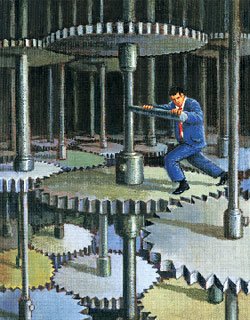VietNamNet Bridge – Since state owned enterprises (SOEs) still cannot prove that
they deserve to be the leader in the national economy, a lot of economists look
at the private economic sector with the hope that this would be the new driving
force for the national economy.

The serious and chronic diseases of state economic sector
In all its official documents, the government affirms that the state economic
sector, with SOEs, play the leading role in the national economy.
However, economists have recently pointed out that SOEs, while using the
majority of economic resources, cannot play their role well.
According to the Central Institute of Economic Management CIEM, SOEs now use 70
percent of the society’s investment capital, 50 percent of the state’s
investment, 60 percent of the total credit and 70 percent of capital from ODA
sources (official development assistance).
Meanwhile, their contribution to the national economy remains modest. SOEs,
including economic groups and general corporations, every year can make up 35
percent of GDP, generate 39.5 percent of the total industrial production value,
50 percent of export turnover and 28.8 percent of the domestic receipts,
according to the Enterprise Renovation Department, an unit of the Government
Office.
A report of the National Assembly’s Economics Committee showed that every year,
12 percent of SOEs report business loss, while the average loss of an SOE is 12
times higher than an enterprise in other economic sectors. The ROA index is 20.8
percent for SOEs, which is much lower than that of foreign invested enterprises.
Meanwhile, the ratio of pretax profit on stockholder equity is just 13.1
percent, which is much lower than the loan interest rate.
Especially, 80 percent of SOEs’ pretax profit comes from four conglomerates
PetroVietnam, Military Telecom, VNPT and rubber group
In Vietnam, a lot of SOEs have been making fat profits because of the privileges
they can enjoy, including the monopoly in their fields. Since the enterprises do
not have to compete with other rivals to survive, they have been operating
badly.
For the last many years, SOEs have been used by the government as the tool to
stabilize the macro economy when necessary. However, economists have commented
that SOEs, with their too many problems, should be seen as the reason behind
macroeconomic instability, rather than a tool to stabilize the macro economy.
Private enterprises weak, fledgling
The idea by the above said economists that the private economic sector should be
seen the driving force for the national economy has caught the special
attention. People, who have got tired of the big losses and ineffective
operation of SOEs, believe that Vietnam needs a “breath of fresh air.”
To some extent, the idea has been shared by the legislation body. In a document
delivered to the National Assembly’s deputies who attended the latest session,
the Economics Committee recorded the new viewpoint.
By repeating the viewpoint of the economist that it’s necessary to consider the
private economic sector as the “main driving force”, or “important driving
force” for the economic growth, the committee has indirectly supported the idea.
Nevertheless, the idea has raised controversy. Dr Pham Thi Thu Hang, Secretary
General of the Vietnam Chamber of Commerce and Industry VCCI, said that most of
private enterprises in Vietnam are small or tiny ones, therefore, it is doubtful
about if the fledgling and weak enterprises can undertake the mission of leading
the national economy.
Source: DDDN
- © Copyright of Vietnamnet Global.
- Tel: 024 3772 7988 Fax: (024) 37722734
- Email: evnn@vietnamnet.vn